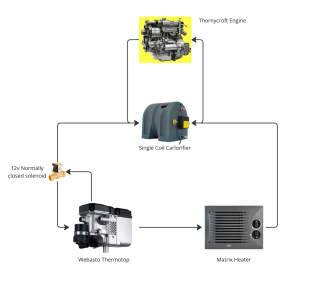laurence_penpol
New member
Hi everyone,
I have just quoted a 33ft Sailing boat and am in the process of putting in some heating to make cruising a little more comfortable in the winter months. I have a single coil calorifier on board which is in good condition which is currently heated by the engine for hot water. I want to add a Websasto diesel water heater into the system so I can get hot water and heating in the winter without switching the engine on, but I am struggling to think of the best approach. I know ideally I would have. a twin coil calorifier but there is only room for a small tank and most at that size dont come with two coils.
Where I have got to in my thinking (pic below) is that an additional heating circuit with the Websasto and Heater Matrix in but with a 12v solenoid valve (normally closed) would do the job in separating the heating from the engine when not using the Webasto heater but allowing both to heat the water. I am trying to minimise the water that the engine would have to pump around beyond the calorifier. The other option is just to disconnect the engine entirely and only use the Webasto on its own separate circuit for heating and hot water.
I was not too worried if the Webasto heated the engine block a little as it will help with short cycling of the heater and is a good overall heat sink, but equally, Im conscious about keeping the engine coolant paths as simple as possible to reduce risks of engine failure. Im also aware I would need a header tank on the Webasto circuit but didn't include that in the diagram.
Any thoughts about the best setup for a single coil calorifier most welcome!

I have just quoted a 33ft Sailing boat and am in the process of putting in some heating to make cruising a little more comfortable in the winter months. I have a single coil calorifier on board which is in good condition which is currently heated by the engine for hot water. I want to add a Websasto diesel water heater into the system so I can get hot water and heating in the winter without switching the engine on, but I am struggling to think of the best approach. I know ideally I would have. a twin coil calorifier but there is only room for a small tank and most at that size dont come with two coils.
Where I have got to in my thinking (pic below) is that an additional heating circuit with the Websasto and Heater Matrix in but with a 12v solenoid valve (normally closed) would do the job in separating the heating from the engine when not using the Webasto heater but allowing both to heat the water. I am trying to minimise the water that the engine would have to pump around beyond the calorifier. The other option is just to disconnect the engine entirely and only use the Webasto on its own separate circuit for heating and hot water.
I was not too worried if the Webasto heated the engine block a little as it will help with short cycling of the heater and is a good overall heat sink, but equally, Im conscious about keeping the engine coolant paths as simple as possible to reduce risks of engine failure. Im also aware I would need a header tank on the Webasto circuit but didn't include that in the diagram.
Any thoughts about the best setup for a single coil calorifier most welcome!


